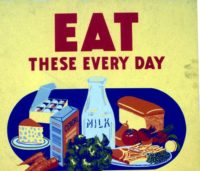Americans’ consumption of dairy foods has remained constant, but for adults (ages 51 to 70) dairy intake has increased. Dairy consumption has decreased for girls ages 4 to 8 years and young adult males. We aren’t eating enough fruit, and (despite the seeming ubiquity of Brussels sprouts on every U.S. menu) vegetable intake has declined, particularly among children of all ages, adolescents, and young adult males.
We’re eating more whole grains and consuming fewer foods with added sugars (yet intakes still exceed the limit in the USDA food patterns).
Of special note to the dairy industry: “If milk is completely eliminated from the diet and replaced by soft drinks, fruit drinks, sports beverages, and other sugar-sweetened beverages, diet quality deteriorates significantly, making it very hard for individuals to meet nutrient recommendations.”
Those are some conclusions in a report released this afternoon by the Dietary Guidelines Advisory Committee. DGAC submitted its recommendations to Health and Human Services Secretary Sylvia M. Burwell and Agriculture Secretary Tom Vilsack. The recommendations will inform the 2015 edition of the Dietary Guidelines for Americans.
HHS and the U.S. Department of Agriculture will consider this report, along with input from other federal agencies and comments from the public as they develop the Dietary Guidelines for Americans, 2015, to be released later this year.
IDFA and NMPF respond to the Dietary Guidelines Advisory Committee
The International Dairy Foods Association and the National Milk Producers Federation responded with this statement:
“We appreciate the commitment of the Dietary Guidelines Advisory Committee (DGAC) to help Americans build healthy eating patterns.
“The essential role of dairy foods, as part of dietary patterns that foster good health outcomes, is supported by the totality of the science — low-fat and fat-free milk and dairy products are a core component of the healthy dietary patterns identified by the Committee.
“The good news for people across the country is that milk, cheese, and yogurt not only taste great, but also are nutrient-rich, affordable, readily available, and versatile, making dairy foods realistic options to help people build healthier meal plans. Milk is the number one source of nine essential nutrients in the diets of America’s children – including calcium, vitamin D, and potassium, three of the four nutrients the 2015 DGAC found to be under-consumed. Dairy foods’ nutrient package can be hard to replace with other foods.
“We will provide science-based comments on the advisory report during the current public comment period and look forward to the release of the 2015 Dietary Guidelines for Americans policy document later this year.”
Below are verbatim excerpts from the report. Download the complete 2015 Dietary Guidelines Advisory Committee.
A healthy diet includes dairy, fruits, vegetables and whole grains
The overall body of evidence examined by the 2015 DGAC identifies that a healthy dietary pattern is higher in vegetables, fruits, whole grains, low- or non-fat dairy, seafood, legumes, and nuts; moderate in alcohol (among adults); lower in red and processed meat; and low in sugar- sweetened foods and drinks and refined grains.
Vegetables and fruit are the only characteristics of the diet that were consistently identified in every conclusion statement across the health outcomes. Whole grains were identified slightly less consistently compared to vegetables and fruits, but were identified in every conclusion with moderate to strong evidence.
For studies with limited evidence, grains were not as consistently defined and/or they were not identified as a key characteristic. Low- or non-fat dairy, seafood, legumes, nuts, and alcohol were identified as beneficial characteristics of the diet for some, but not all, outcomes. For conclusions with moderate to strong evidence, higher intake of red and processed meats was identified as detrimental compared to lower intake.
Higher consumption of sugar-sweetened foods and beverages as well as refined grains was identified as detrimental in almost all conclusion statements with moderate to strong evidence.
Thus, the U.S. population should be encouraged and guided to consume dietary patterns that are rich in vegetables, fruit, whole grains, seafood, legumes, and nuts; moderate in low- and non-fat dairy products and alcohol (among adults); lower in red and processed meat; and low in sugar- sweetened foods and beverages and refined grains.
These dietary patterns can be achieved in many ways and should be tailored to the individual’s biological and medical needs as well as socio-cultural preferences. It will take concerted, bold actions on the part of individuals, families, communities, industry, and government to achieve and maintain the healthy diet patterns and the levels of physical activity needed to promote the health of the U.S. population.
These actions will require a paradigm shift to an environment in which population health is a national priority and where individuals and organizations, private business, and communities work together to achieve a population-wide “culture of health” in which healthy lifestyle choices are easy, accessible, affordable, and normative—both at home and away from home. In such a culture, health care and public health professionals also would embrace a new leadership role in prevention, convey the importance of lifestyle behavior change to their patients/clients, set standards for prevention in their own facilities, and help patients/clients in accessing evidence-based and effective nutrition and comprehensive lifestyle services and programs.
Within the Dairy and Vegetable groups, the following dietary changes in particular will help increase intake of shortfall nutrients and will decrease intake of overconsumed nutrients by the U.S. population:
Increasing low-fat/fat-free fluid milk and yogurt and decreasing cheese would result in higher intakes of magnesium, potassium, vitamin A, and vitamin D while simultaneously decreasing 1000 the intake of sodium and saturated fat.
Replacing soft drinks with nonfat milk reduces empty calories ‘substantially’
Replacing soft drinks and other sugar-sweetened beverages (including sports drinks) with non-fat fluid milk would substantially reduce added sugars and empty calories and increase the intake of shortfall nutrients, including calcium, vitamin D, and magnesium.
Consuming all vegetables, including starchy vegetables, with minimal additions of salt and solid fat will help minimize intake of overconsumed nutrients – sodium and saturated fat.
If milk is completely eliminated from the diet and replaced by soft drinks, fruit drinks, sports beverages, and other sugar-sweetened beverages, diet quality deteriorates significantly, making it very hard for individuals to meet nutrient recommendations (see Appendix E-3.6: Dairy Group and Part D. Chapter 1: Food and Nutrient Intakes, and Health: Current Status and Trends Scientific Report of the 2015 Dietary Guidelines Advisory Committee 33 Alternatives, Table 6). Indeed, among U.S. adolescents’ milk consumption is very low as are intakes of the “shortfall” nutrients.
The U.S. population has made few dietary changes over time:
• Fruit intake has remained low but stable.
• Vegetable intake has declined, particularly among children of all ages, adolescents, and young adult males.
• Whole grain intake has slightly increased between 2001-2004 and 2007-2010, particularly among middle aged and older adults.
• Dairy intake has been relatively constant over time, but has decreased for girls ages 4 to 8 years and young adult males, and has increased for adults ages 51 to 70 years.
• Added sugars intake has decreased for both males and females across all age groups between 2001-2004 and 2007-2010, but intakes still exceed the limit in the USDA food patterns.



